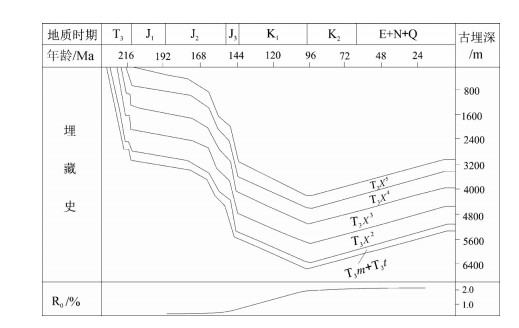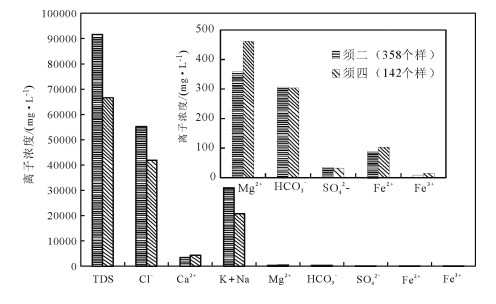A study of the coupling relationship between overpressure evolution and formation water of Xujiahe Formation in Xincang structure area, west Sichuan depression
-
摘要:
沉积盆地超压体系是油气勘探与开发过程中一个不容忽视的问题,不仅影响了地质流体的运移和聚集,更为勘探带来安全隐患。以实测地压和油田水化学数据为基础,对川西坳陷新场构造带须四段和须二段现今地层水矿化度与现今压力系数关系进行比较,结合地层水特征系数和阴阳离子关系,综合前人研究结果,对须四段和须二段压力演化史与地层水演化过程进行分析,考察川西坳陷须家河组超压系统演化与地层水演化的耦合关系。结果表明,须家河组超压发育与地层水具有密切的联系:①须家河组储层段压力分布范围较广,在弱超压至超强压之间,须二段属于中超压而须四段属于超高压,平面分布中须二段探测井中矿化度随压力系数增加而减少,须四段则相反;②在压实过程中,由于流体排驱受阻导致“欠压实”超压的产生,随着超压的不断积聚,局部出现裂缝,导致地层水更加强烈的混合作用和运移;③生烃作用导致自生压力增大,地层水离子水岩作用强烈,造成流体包裹体与现今地层水离子成分分异;④构造挤压抬升过程中,须四段裂缝不发育,压力进一步升高,须二段则产生泄压,出现了凝析水和水侵现象,造成须四段和须二段现今地层水特征的差异。
Abstract:Overpressure systems in sedimentary basins not only affect the migration and accumulation of geological fluid but also bring potential hazard for exploration. Formation water salinity, pressure coefficient, characteristic coefficient and ions relationships of the second and fourth member of Xujiahe Formation (T3X2, T3X4) in western Sichuan Basin were integrated and utilized to study the coupling relationship between overpressure system and formation water. The results show that the development of overpressure is closely related to the formation water: (1) the formation pressure varies from weak overpressure to super overpressure in Xujiahe Formation. T3X2 belongs to medium overpressure, while T3X4 is super overpressure. The fluid salinity of exploration wells in T3X2 decreases with increments of pressure coefficient, which yields opposite relationship in T3X4. (2) Fluid expulsion leads to "undercompaction" overpressure during compaction, resulting in the occurrence of fractures and pronounced mixture and migration of formation water. (3) The maturation of organic matter results in the increment of pressure and the composition difference between fluid inclusions and formation water due to extensive water-rock reaction. (4) The scarcity of fractures in T3X4 results in the increment of formation pressure, while the condensate water and water invasion in T3X2 results from the development of fractures during uplift. Thus, T3X2 and T3X4 display nonidentical characteristics of formation water.
-
致谢: 项目工作得到中石化西南油气分公司项目负责人的帮助,在此表示感谢。
-
图 1 新场地区须家河组构造图(据参考文献[14]修改)
Figure 1. Geological structures of Xujiahe Formation in Xinchang area
图 2 川西坳陷上三叠统主要界面埋藏史曲线(据参考文献[19]修改)
T—三叠纪;J—侏罗纪;K—白垩纪;E+N—古近纪-新近纪;Q—第四纪;T3X2-T3X6—须二段-须六段;T3m+T3t—马鞍塘组-小塘子组
Figure 2. Burial and thermal histories characteristics of major interface of western Sichuan depression
图 5 新场构造带须家河组地层压力演化过程(据参考文献[6]修改)
T—三叠纪;J—侏罗纪;K—白垩纪;E—古近纪;N—新近纪;Q—第四纪;MZ—中生代;CZ—新生代
Figure 5. The process of formation pressure evolution in Xinchang area
表 1 川西坳陷沉积速率
Table 1 Deposition rate of western Sichuan depression
地层 年代/Ma 厚度/m 沉积速率/(m·Ma-1) T3x(须家河组) 223~208 3900 260 J1b(白田坝组) 208~189 300 15.8 J2q(千佛崖组) 189~175 250 17.9 J2s+x(沙溪庙组) 175~161 1500 107.1 J3sn(遂宁组) 161~154 300 42.8 J3p(蓬莱镇组) 154~144 1800 180 K1—E(下白垩统—古近系) 144~25 1500 12.6 -
沈忠民, 宫亚军, 刘四兵, 等.川西坳陷新场地区上三叠统须家河组地层水成因探讨[J].地质论评, 2010, 56(1):82-88. http://www.cnki.com.cn/Article/CJFDTOTAL-DZLP201001013.htm 雷振宇, 解习农, 孟元林, 等.松辽盆地北部中央坳陷带异常压力条件下地层水化学特征及其成岩响应[J].石油实验地质, 2013, 35(1):81-86. http://www.wanfangdata.com.cn/details/detail.do?_type=perio&id=sysydz201301016 Mark J O, Richard E S. Mechanisms for generating overpressure in sedimentary basins:A revaluation[J]. AAPG Bulletin, 1997, 81(6):1023-1041. https://www.osti.gov/scitech/biblio/494207
Magnus W. A quantitative comparison of some mechanisms generating overpressure in sedimentary basins[J]. Tectonophysics, 2001, 334(3):211-234. https://www.sciencedirect.com/science/article/pii/S0040195101000646
郝芳.超压盆地生烃作用动力学与油气成藏机理[M].北京:科学出版社, 2004. 郭迎春, 庞雄奇, 陈冬霞, 等.川西坳陷中段陆相地层压力演化及其成藏意义[J].石油勘探与开发, 2012, 39(4):426-433. http://cpfd.cnki.com.cn/Article/CPFDTOTAL-ZSYH201109001015.htm Du X, Xie X, Lu Y, et al. Hydrogeochemistry of formation water in relation to overpressures and fluid flow in the Qikou Depression of the Bohai bay basin, China[J]. Journal of Geochemical Exploration, 2010, 106(1/3):77/83. https://www.sciencedirect.com/science/article/pii/S0375674209001381
王冰洁, 何生, 王静.东营凹陷水化学场成因及其与超压系统耦合关系[J].中国石油大学学报(自然科学版), 2012, 36(3):54-64. http://www.cnki.com.cn/Article/CJFDTOTAL-SYDX201203008.htm He S, Middleton M, Tang Z H. Characteristics and origin of underpressure system in the Shiwu Fault Depression, south-east Songliao Basin, China[J]. Basin Research, 2000, 12(2):147-158. doi: 10.1046/j.1365-2117.2000.00118.x
Me X N, Jiao J J, Cheng J M. Regional variation of formation water chemistry and diagenesis reaction in underpressured system:example from Shiwu depression of Songliao basin, NE China[J]. Journal of Geochemical Exploration, 2003, 78/79(SI):585-590. http://www.sciencedirect.com/science/article/pii/S0375674203000281
王震亮, 孙明亮, 张立宽, 等.川西地区须家河组异常压力演化与天然气成藏模式[J].地球科学, 2004, 29(4):433-439. http://www.wanfangdata.com.cn/details/detail.do?_type=perio&id=dqkx200404009 张金川, 刘丽芳, 唐玄, 等.川西坳陷根缘气藏异常地层压力[J].地学前缘, 2008, 15(2):147-154. http://cpfd.cnki.com.cn/Article/CPFDTOTAL-ZGSY200910001030.htm 徐国盛, 刘中平.川西地区上三叠统地层古压力形成与演化的数值模拟[J].石油实验地质, 1996, 18(1):117-126. doi: 10.11781/sysydz199601117 李林涛, 庞雄奇, 熊亮, 等.运用剥蚀量恢复技术进行构造圈闭演化研究——以川西坳陷中段须家河组为例[J].天然气地球科学, 2010, 21(3):441-448. http://www.wanfangdata.com.cn/details/detail.do?_type=perio&id=trqdqkx201003015 罗啸泉, 陈兰.川西坳陷形成演化及其与油气的关系[J].油气地质与采收率, 2004, 11(1):16-19. http://www.wanfangdata.com.cn/details/detail.do?_type=perio&id=yqdzycsl200401006 于福生, 王彦华, 李晓剑, 等.川西坳陷孝泉-丰谷构造带变形特征及成因机制模拟[J].地球科学与环境学报, 2011, 33(1):45-53. http://www.wanfangdata.com.cn/details/detail.do?_type=perio&id=xagcxyxb201101006 李智武, 刘树根, 林杰, 等.川西坳陷构造格局及其成因机制[J].成都理工大学学报(自然科学版), 2009, 36(6):645-653. http://www.cnki.com.cn/Article/CJFDTOTAL-CDLG200906011.htm 罗启后.再论水进型三角洲——兼论四川盆地须家河组巨厚砂层成因[J].沉积学报, 2015, 33(5):845-854. http://www.cqvip.com/QK/95994X/201505/666513155.html 李嵘, 张娣, 朱丽霞.四川盆地川西坳陷须家河组砂岩致密化研究[J].石油实验地质, 2011, 33(3):274-281. doi: 10.11781/sysydz201103274 陈科贵, 温易娜, 何太洪, 等.低孔低渗致密砂岩气藏束缚水饱和度模型建立及应用——以苏里格气田某区块山西组致密砂岩储层为例[J].天然气地球科学, 2014, 25(2):273-277. http://www.cnki.com.cn/Article/CJFDTOTAL-TDKX201402017.htm 朱如凯, 罗平, 罗忠.塔里木盆地晚泥盆世及石炭纪岩相古地理[J].古地理学报, 2002, 4(1):13-24. doi: 10.7605/gdlxb.2002.01.002 李宇平, 王勇, 孙玉善, 等.塔里木盆地中部地区志留系油藏两期成藏特征[J].地质科学, 2002, 37(S1):45-50. http://www.cqvip.com/QK/94066X/2002z1/1000431122.html 王清华, 唐子军, 赵福元, 等.塔里木盆地志留系成藏地质条件与油气勘探前景[J].新疆石油地质, 2009, 30(2):168-170. http://www.wanfangdata.com.cn/details/detail.do?_type=perio&id=xjsydz200902005 刘树根, 徐国盛, 徐国强, 等.四川盆地天然气成藏动力学初探[J].天然气地球科学, 2004, 15(4):323-330. http://www.wanfangdata.com.cn/details/detail.do?_type=perio&id=trqdqkx200404001 冷济高, 杨克明, 杨宇.川西坳陷孝泉-丰谷构造带须家河组超压与天然气成藏关系研究[J].石油实验地质, 2011, 33(06):574-579. doi: 10.3969/j.issn.1001-6112.2011.06.004 林小兵, 刘莉萍, 田景春, 等.川西坳陷合兴场-丰谷地区须家河组致密砂岩气藏精细勘探[J].石油与天然气地质, 2013, 34(1):77-84. doi: 10.11743/ogg20130110 陆正元, 孙冬华, 黎华继, 等.气藏凝析水引起的地层水矿化度淡化问题——以四川盆地新场气田须二段气藏为例[J].天然气工业, 2015, 35(7):60-65. http://www.cnki.com.cn/Article/CJFDTotal-TRQG201507014.htm 刘树根, 徐国盛, 徐国强, 等四川盆地天然气成藏动力学初探[J].天然气地球科学, 2004, 15(4):323-330. http://www.wanfangdata.com.cn/details/detail.do?_type=perio&id=trqdqkx200404001 郝芳, 董伟良.沉积盆地超压系统演化、流体流动与成藏机理[J].地球科学进展, 2001, 16(1):79-85. http://www.cqvip.com/QK/94287X/200101/4889208.html 张金亮, 常象春.四川盆地上三叠统深盆气藏研究[J].石油学报, 2002, 23(3):29-33. http://industry.wanfangdata.com.cn/dl/Detail/Periodical?id=Periodical_syxb200203006 邹才能, 陶士振, 袁选俊, 等."连续型"油气藏及其在全球的重要性:成藏、分布与评价[J].石油勘探与开发, 2009, 36(6):669-682. http://mall.cnki.net/magazine/Article/SKYK200906003.htm 孙明亮, 柳广弟, 李剑.超压体系内天然气成藏的源储能量配置[J].天然气地球科学, 2007, 18(2):215-218. http://www.oalib.com/paper/1417391 丁道桂, 汤良杰.塔里木盆地形成与演化[M].南京:河海大学出版社, 1996. 李伟, 秦胜飞.四川盆地须家河组地层水微量元素与氢氧同位素特征[J].石油学报, 2012, 33(1):55-63 doi: 10.7623/syxb201201007 赵永胜, 周文.川西坳陷须二气藏凝析水地球化学特征及成因初探[J].天然气地球科学, 1995, (01):30-33 http://mall.cnki.net/magazine/Article/TDKX1999Z2009.htm 叶礼友, 高树生, 杨洪志, 等.致密砂岩气藏产水机理与开发对策[J].天然气工业, 2015, 35(2):41-46 http://www.cnki.com.cn/Article/CJFDTotal-TRQG201502008.htm 庞河清, 匡建超, 罗桂滨, 等.川西新场气田须二气藏水体动态分布与水化学特征[J].天然气地球科学, 2012, 23(1):190-197. http://www.oalib.com/paper/5024349




 下载:
下载:










